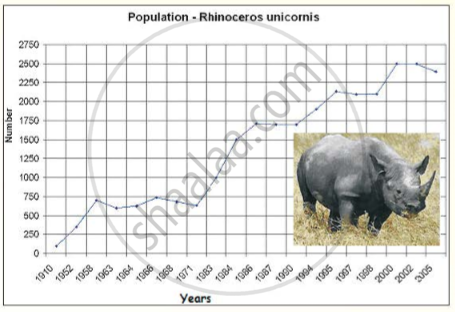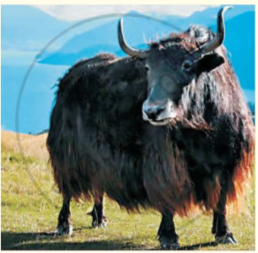Advertisements
Advertisements
Question
Read this article about the great Indian Rhinoceros. [You will find the information useful for your group discussion in 5.]
The Indian Rhinoceros or the Great One-Horned Rhinoceros or the Asian Onehorned Rhinoceros (Rhinoceros unicomis) is a large mammal primarily found in north-eastern India, Nepal and parts of Bhutan. It is confined to the tall grasslands and forests in the foothills of the Himalayas.
The Indian Rhinoceros once ranged throughout the entire stretch of the Indo Gangetic Plain but excessive hunting reduced their natural habitat drastically.
Today, about 3,000 Indian Rhinos live in the wild, 1,800 of which are found in Assam alone. In 2008, more than 400 Indian Rhinos were sighted in Nepal's Chitwan National Park.
In size it is equal to that of the White Rhino in Africa; together they are the largest of all rhino species. The Great One-Horned Rhinoceros has a single horn; this is present in both males and females, but not on newborn young. In most adults, the horn reachee a length of about 25 centimetres, but has been recorded up to 57 .2 centimetres in length. The nasal hom curves backwards from the nose. The horn is naturally black.
This prehistoric-looking rhinoceros bas thick, silver-brown skin which becomes pinkish near the large skin folds that cover its body. The male develops thick neckfolds. It has very little body hair aside from eyelashes, ear-fringes and tail-brush.
These rhinos live in tall grasslands and riverine forests, but due to the loss of habitat, they have been forced towards cultivated land. They are mostly solitary creatures, with the exception of mothers and calves and breeding pairs, although they sometimes, congregate at bathing areas.

The Indian Rhinoceros makes a wide variety of vocalizations. At least ten distinct vocalizations have been identified: snorting, honking, bleating, roaring, squeak panting, moo-grunting, shrieking, groaning, rumbling and humphing. In addition to noises, the rhino also uses olfactory communication.
In aggregation, Indian Rhinos are often friendly. They will often greet each other by waving or bobbing their heads, mounting flanks, nuzzling noses, or licking. Rhinos will playfully spar, run around, and play with twigs in their mouth. Adult males are the primary instigators of fights. Fights between dominant males are the most common cause of rhino mortality. Indian rhinos have few natural enemies, except for tigers. Tigers sometimes kill unguarded calves, but adult rhinos are less vulnerable due to their size. Humans are the only other animal threat, hunting the rhinoceros primarily for sport or for the use of its horn. Indian Rhinos have been somewhat tamed and trained in circuses, but they remain dangerous and unpredictable animals.
In the nineteenth and early twentieth century, the Indian Rhinoceros was hunted relentlessly. Reports from the middle of the nineteenth century claim that some military officers in Assam individually shot more than 200 rhinos. In the early 1900s, officials became concerned at the rhinos' plummeting numbers. By 1908 in Kaziranga, one of the Rhinos' main ranges, the population had fallen to around 12 individuals. In 1910, all rhino hunting in India became prohibited.
The rhino has been a major success in conservation. Only 100 remained in the early 1900s; a century later, their population has increased to about 2500 again, but even so, the species is still endangered. The Indian rhino is illegally poached for its horn. Some cultures in East Asia believe that the hair has healing and potency powers and therefore is used for traditional Chinese medicine and other Oriental medicines.
The Indian and Nepalese Governments have taken major steps towards Indian Rhinoceros conservation with the help of the World Wildlife Fund (WWF). The Kaziranga National Park and Manas National Park in Assam, Pobitora Reserve Forest in Assam {having the highest Indian rhino density in the world), Orang National Park of Assam, Laokhowa Reserve Forest of Assam (having a very small population) and Royal Chitwan National Park in Nepal are homes to this endangered animal.
Solution
Summary of the extract :
The Indian Rhinoceros is mainly found in north eastern part of the Indian peninsula. During early 1900s the population of rhino dipped to as low as about 100. Rhino conservation in India is a success story with current population standing at about 3000. Rhinos are usually solitary animals but make group for reproduction. They are big animals and have virtually no enemy because of their size. They are poached for their horns which are supposed to have aphrodisiac properties. Kaziranga is one of the major sanctuaries for rhinos.

| DOMESTIC YAK |
| herd animals 2-2.2 m tall |
| used in sports |
| kept for milk , fur , fibre , meat , drawing ploughs etc |

| WILD YAK |
| length:3-3. 4m |
|
habitat: treeless uplands
|
| killed for food |
| insulated from cold by dense, close matted under hair , shaggy outer hair |
| hunted for similar reasons as the domestic ones |
APPEARS IN
RELATED QUESTIONS
When we meet people, we notice their faces more than anything else. The box below contains words which describe the features of a face. Work in pairs and list them under the appropriate headings, then add more words of your own.
| twinkling | shifty | discoloured | short | oval |
| pear-shaped | large | close-cropped | broken | long |
| protruding | gapped | thick | pointed | wide |
| fair | thin | pale | swarthy | staring |
| square | round | untidy | close-set | neat |
| wavy | upturned |
| Shape of face | Complexion | Eyes | Hair | Nose | Lips | Teeth |
Notice how ideas are connected in the story.
Write what the following words you just used in 1.1 imply by choosing suitable options from the box.
- and:
- but:
- where:
- while:
- after:
- until:
- so :
connects similar actions, objects
denotes contrast
denotes time.
The words given above are called connectors. Connectors do not simply join sentences together; they also show how ideas are related.
There are many different ways of classifying connectors according to their meaning. We shall start with the ones you are already familiar with.
Some are like fields of sunlit corn,
Meet for a bride on her bridal morn,
Some, like the flame of her marriage fire,
Or, rich with the hue of her heart's desire,
Tinkling,luminous,tender, and clear,
Like her bridal laughter and bridal tear.
Read the lines given above and answer the question that follow.
Mention the colours of the bangles in this stanza. What do they represent?
He looked at me very blankly and tiredly, and then said, having to share his worry with someone, “The cat will be all right, I am sure. There is no need to be unquiet about the cat. But the others. Now what do you think about the others?”
“Why they’ll probably come through it all right.”
“You think so?”
“Why not,” I said, watching the far bank where now there were no carts.
“But what will they do under the artillery when I was told to leave because of the artillery?”
“Did you leave the dove cage unlocked?” I asked.
“Yes.”
“Then they’ll fly.”
“Yes, certainly they’ll fly. But the others. It’s better not to think about the others,” he said.
Read the extract given below and answer the question that follow.
What does the old man worry about? Why?
He flungs himself down in a corner to recoup from the fatigue of his visit to the shop. His wife said, “You are getting no sauce today, nor anything else. I can’t find anything to give you to eat. Fast till the evening, it’ll do you good. Take the goats and be gone now,” she cried and added, “Don’t come back before the sun is down.”
Read the extract given below and answer the question that follow.
Did The shopkeeper give Muni what he needed? Why/ Why not?
“Jane,” said the wheelwright, with an impressiveness of tone that greatly subdued his wife, “I read in the Bible sometimes, and find much said about little children. How the Savior rebuked the disciples who would not receive them; how he took them up in his arms, and blessed them; and how he said that ‘whosoever gave them even a cup of cold water should not go unrewarded.’ Now, it is a small thing for us to keep this poor motherless little one for a single night; to be kind to her for a single night; to make her life comfortable for a single night.”
The voice of the strong, rough man shook, and he turned his head away, so that the moisture in his eyes might not be seen. Mrs. Thompson did not answer, but a soft feeling crept into her heart.
“Look at her kindly, Jane; speak to her kindly,” said Joe. “Think of her dead mother, and the loneliness, the pain, the sorrow that must be on all her coming life.” The softness of his heart gave unwonted eloquence to his lips.
Read the extract given below and answer the question that follow.
What brought eloquence to Joe’s lips when he spoke to his wife?
Which word is the opposite of ‘badly’?
Answer the following question. (Refer to that part of the text whose number is given against the question. This applies to the comprehension questions throughout the book.)
What did Patrick think his cat was playing with?
What was it really? (2)
Look at these sentences.
1. “Too boring,” he said.
2. Cleaned his room, did his chores.
When we speak, we often leave out words that can easily be guessed. We do not do this when we write unless we are trying to write as we speak (as in the story).
So, if we were to write carefully, we would say:
- “Homework is too boring,” he said.
- He cleaned his room and did his chores.
What does the phrase “take to task in the above passage mean?
